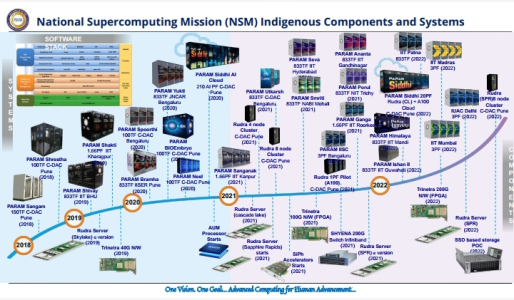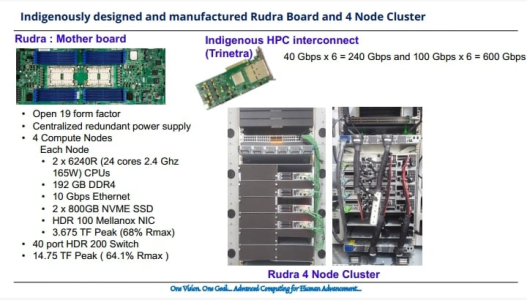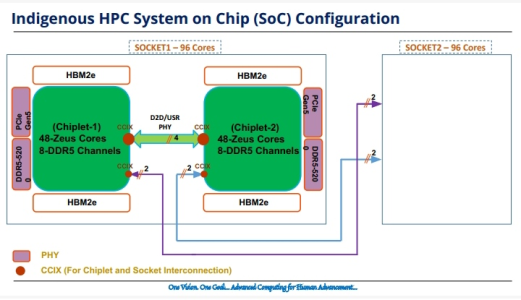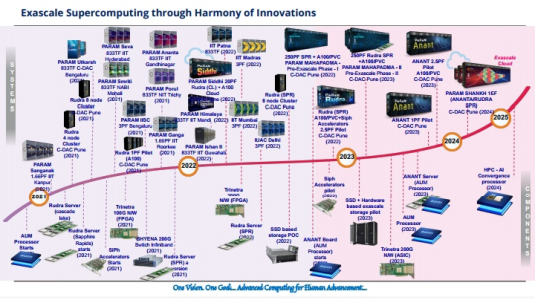You are using an out of date browser. It may not display this or other websites correctly.
You should upgrade or use an alternative browser.
You should upgrade or use an alternative browser.
Super & Quantum computing in India
- Thread starter SKC
- Start date
More options
Who Replied?- Joined
- Jun 27, 2024
- Messages
- 1,766
- Likes
- 5,279
National Supercomputing Mission was launched back in 2017 with aim to building total of 80 Supercomputer in next 7 years.
More Info on:
https://timesofindia.indiatimes.com...rs-by-2017/articleshow/52395973.cms?pcode=461
More Info on:
https://timesofindia.indiatimes.com...rs-by-2017/articleshow/52395973.cms?pcode=461
- Joined
- Jun 27, 2024
- Messages
- 1,766
- Likes
- 5,279
More on initial plan from 2017:
India to get indigenously-built supercomputer under a massive mission plan by 2017
Under the National Supercomputing Mission’s plan, which got an approval from the government in March last year, in next 7 years 80 supercomputers will be built.
India is all set to have an indigenously-built supercomputer by 2017. Government has launched a Rs 4,500-crore programme, which aims at helping India enter an elite league of nations who have made advancements in the field. The project is being handled by the Centre for Development of Advanced Computing, said Ashutosh Sharma, Secretary in the Ministry of Science and Technology. Param, India’s first supercomputer was also built by the Centre for Development of Advanced Computing.
Under the National Supercomputing Mission’s plan, which got an approval from the government in March last year, in next 7 years 80 supercomputers will be built. “Some of them will be imported and the rest will be built be indigenously. The first one will come up by August 2017,” said Sharma.
“We are working on how to control heat. The cost of power to run these supercomputers alone will be around Rs 1,000 crore,” he added. The new supercomputers will be kept in different institutes across the country. “A supercomputer can be used for various purposes like climate modeling, weather forecast, discoveries of drugs among others,” Sharma said. US, Japan, China and the European Union currently account for a major share of the top supercomputing machines in the world.
http://www.newsnation.in/article/132391-india-to-build-80-new-supercomputers-in-next-7-years.html
India to get indigenously-built supercomputer under a massive mission plan by 2017
Under the National Supercomputing Mission’s plan, which got an approval from the government in March last year, in next 7 years 80 supercomputers will be built.
India is all set to have an indigenously-built supercomputer by 2017. Government has launched a Rs 4,500-crore programme, which aims at helping India enter an elite league of nations who have made advancements in the field. The project is being handled by the Centre for Development of Advanced Computing, said Ashutosh Sharma, Secretary in the Ministry of Science and Technology. Param, India’s first supercomputer was also built by the Centre for Development of Advanced Computing.
Under the National Supercomputing Mission’s plan, which got an approval from the government in March last year, in next 7 years 80 supercomputers will be built. “Some of them will be imported and the rest will be built be indigenously. The first one will come up by August 2017,” said Sharma.
“We are working on how to control heat. The cost of power to run these supercomputers alone will be around Rs 1,000 crore,” he added. The new supercomputers will be kept in different institutes across the country. “A supercomputer can be used for various purposes like climate modeling, weather forecast, discoveries of drugs among others,” Sharma said. US, Japan, China and the European Union currently account for a major share of the top supercomputing machines in the world.
http://www.newsnation.in/article/132391-india-to-build-80-new-supercomputers-in-next-7-years.html
- Joined
- Jun 27, 2024
- Messages
- 1,766
- Likes
- 5,279
Top 5 Super computers as per TOP500 list released just in June-2024:
| Rank | System | Cores | Rmax (PFlop/s) | Rpeak (PFlop/s) | Power (kW) |
|---|---|---|---|---|---|
| 1 | Frontier - HPE Cray EX235a, AMD Optimized 3rd Generation EPYC 64C 2GHz, AMD Instinct MI250X, Slingshot-11, HPE DOE/SC/Oak Ridge National Laboratory United States | 8,699,904 | 1,206.00 | 1,714.81 | 22,786 |
| 2 | Aurora - HPE Cray EX - Intel Exascale Compute Blade, Xeon CPU Max 9470 52C 2.4GHz, Intel Data Center GPU Max, Slingshot-11, Intel DOE/SC/Argonne National Laboratory United States | 9,264,128 | 1,012.00 | 1,980.01 | 38,698 |
| 3 | Eagle - Microsoft NDv5, Xeon Platinum 8480C 48C 2GHz, NVIDIA H100, NVIDIA Infiniband NDR, Microsoft Azure Microsoft Azure United States | 2,073,600 | 561.20 | 846.84 | |
| 4 | Supercomputer Fugaku - Supercomputer Fugaku, A64FX 48C 2.2GHz, Tofu interconnect D, Fujitsu RIKEN Center for Computational Science Japan | 7,630,848 | 442.01 | 537.21 | 29,899 |
| 5 | LUMI - HPE Cray EX235a, AMD Optimized 3rd Generation EPYC 64C 2GHz, AMD Instinct MI250X, Slingshot-11, HPE EuroHPC/CSC Finland | 2,752,704 | 379.70 | 531.51 | 7,107 |
- Joined
- Jun 27, 2024
- Messages
- 1,766
- Likes
- 5,279
Top 25 countries:
India at position 21 with only 4 currently in Top 500.
China moved out from Top 10.
| Countries | Count | System Share (%) | Rmax (GFlops) | Rpeak (GFlops) | Cores | |
|---|---|---|---|---|---|---|
| 1 | United States | 171 | 34.2 | 4,408,382,050 | 6,968,768,506 | 47,911,528 |
| 2 | China | 80 | 16 | 356,860,484 | 627,663,427 | 21,128,112 |
| 3 | Germany | 40 | 8 | 274,903,370 | 421,218,896 | 4,399,212 |
| 4 | Japan | 29 | 5.8 | 672,085,510 | 888,124,068 | 11,077,432 |
| 5 | France | 24 | 4.8 | 232,747,500 | 363,366,104 | 4,346,072 |
| 6 | United Kingdom | 16 | 3.2 | 89,372,064 | 151,586,734 | 2,047,152 |
| 7 | South Korea | 13 | 2.6 | 186,445,000 | 246,067,510 | 2,293,652 |
| 8 | Italy | 11 | 2.2 | 332,618,330 | 436,291,218 | 4,079,600 |
| 9 | Canada | 10 | 2 | 41,208,360 | 71,911,529 | 845,984 |
| 10 | Netherlands | 9 | 1.8 | 84,723,520 | 147,850,060 | 847,392 |
| 11 | Poland | 8 | 1.6 | 65,751,460 | 104,597,510 | 438,944 |
| 12 | Brazil | 8 | 1.6 | 53,621,650 | 101,912,142 | 806,656 |
| 13 | Saudi Arabia | 8 | 1.6 | 99,398,340 | 152,763,114 | 2,737,652 |
| 14 | Sweden | 7 | 1.4 | 50,090,910 | 72,173,166 | 448,704 |
| 15 | Russia | 7 | 1.4 | 73,715,000 | 101,737,460 | 741,328 |
| 16 | Taiwan | 6 | 1.2 | 53,895,080 | 77,560,100 | 600,688 |
| 17 | Australia | 5 | 1 | 55,638,310 | 74,947,805 | 498,848 |
| 18 | Switzerland | 5 | 1 | 312,137,040 | 412,264,920 | 1,972,192 |
| 19 | Norway | 5 | 1 | 15,955,310 | 24,963,990 | 425,920 |
| 20 | Ireland | 4 | 0.8 | 11,394,210 | 22,450,170 | 290,560 |
| 21 | India | 4 | 0.8 | 19,453,340 | 25,251,886 | 325,832 |
| 22 | Singapore | 3 | 0.6 | 9,037,830 | 15,785,890 | 234,112 |
| 23 | Czechia | 3 | 0.6 | 17,991,180 | 21,784,990 | 360,192 |
| 24 | Spain | 3 | 0.6 | 221,872,600 | 306,102,991 | 1,542,016 |
| 25 | Finland | 3 | 0.6 | 391,388,310 | 546,192,585 | 3,116,992 |
India at position 21 with only 4 currently in Top 500.
China moved out from Top 10.
- Joined
- Jun 27, 2024
- Messages
- 1,766
- Likes
- 5,279
PM Modi inaugurates supercomputer 'Param Shivay' at IIT-BHU
Capacity - 883 teraflop
Built at the cost of Rs 32.5 crore under the National Super Computing Mission at Indian Institute of Technology (IIT), Banaras Hindu University (BHU)
Other Features:
1 petabyte secondary storage,
appropriate open source system
223 processor nodes,
384 GB per node DDR4 RAM,
parallel file system
https://www.indiatoday.in/education...er-param-shivay-at-iit-bhu-1462501-2019-02-22
PM Modi launched the supercomputer 'Param Shivay' at IIT-BHU on February 19, 2019. This supercomputer centre will help deal with social issues faced by common people.
Capacity - 883 teraflop
Built at the cost of Rs 32.5 crore under the National Super Computing Mission at Indian Institute of Technology (IIT), Banaras Hindu University (BHU)
Other Features:
1 petabyte secondary storage,
appropriate open source system
223 processor nodes,
384 GB per node DDR4 RAM,
parallel file system
https://www.indiatoday.in/education...er-param-shivay-at-iit-bhu-1462501-2019-02-22
- Joined
- Jun 27, 2024
- Messages
- 1,766
- Likes
- 5,279
Back in November 2020, we breached Top100 list:
Param Siddhi, the high-performance computing-artificial intelligence (HPC-AI) supercomputer established under National Supercomputing Mission (NSM) at C-DAC, has achieved a global ranking of 63 in TOP 500 most powerful non-distributed computer systems in the world released on 16 November 2020.
The supercomputer with Rpeak of 5.267 Petaflops and 4.6 Petaflops Rmax (Sustained) was conceived by C-DAC and developed jointly with the support of Department of Science and Technology (DST), Ministry of Electronics and Information Technology (MeitY) under NSM.
Param Siddhi Supercomputer is built on the NVidia DGX SuperPOD reference architecture networking along with C-DAC’s indigenously developed HPC-AI engine, software frameworks and cloud platform and will help deep learning, visual computing, virtual reality, accelerated computing, as well as graphics virtualization.
https://www.thestatesman.com/india/indias-param-siddhi-ai-supercomputer-ranked-63-500-top-powerful-supercomputers-world-1502935988.html
Param Siddhi, the high-performance computing-artificial intelligence (HPC-AI) supercomputer established under National Supercomputing Mission (NSM) at C-DAC, has achieved a global ranking of 63 in TOP 500 most powerful non-distributed computer systems in the world released on 16 November 2020.
The supercomputer with Rpeak of 5.267 Petaflops and 4.6 Petaflops Rmax (Sustained) was conceived by C-DAC and developed jointly with the support of Department of Science and Technology (DST), Ministry of Electronics and Information Technology (MeitY) under NSM.
Param Siddhi Supercomputer is built on the NVidia DGX SuperPOD reference architecture networking along with C-DAC’s indigenously developed HPC-AI engine, software frameworks and cloud platform and will help deep learning, visual computing, virtual reality, accelerated computing, as well as graphics virtualization.
https://www.thestatesman.com/india/indias-param-siddhi-ai-supercomputer-ranked-63-500-top-powerful-supercomputers-world-1502935988.html
- Joined
- Jun 27, 2024
- Messages
- 1,766
- Likes
- 5,279
I am struggling to see any progress on ground. We were supposed to get 80 new installations in 7 years i.e by end of 2024.
I have heard about hardly 5-6 systems from 2017.
Is there any latest report from Govt?
@Indx TechStyle - do you have any latest update on this?
I have heard about hardly 5-6 systems from 2017.
Is there any latest report from Govt?
@Indx TechStyle - do you have any latest update on this?
- Joined
- Jun 27, 2024
- Messages
- 1,766
- Likes
- 5,279
India adds another supercomputer at Mohali under national mission:
Nov 2021:The supercomputing mission gave the country its first machine capable of petascale computing. Petascale computing refers to the ability to add at least a quadrillion (1,000 trillion) real numbers in a second
Some interesting details:
So far, at least six other supercomputers have been established or are soon to be under the mission – a 797 teraflops supercomputer at Indian Institute of Science Education and Research (Pune), 833 teraflops supercomputer in IIT (Banaras Hindu University), a 1.6 petaflops supercomputer in IIT Kharagpur, a 1.3 petaflops supercomputer at IIT-Kanpur, an 838 petaflops supercomputer at Jawaharlal Nehru Centre for Advanced Scientific Research, and a 650 teraflops supercomputer at IIT Hyderabad.
The supercomputing mission gave the country its first machine capable of petascale computing. Petascale computing refers to the ability to add at least a quadrillion (1,000 trillion) real numbers in a second. That computer speed is equivalent to 5,000-6,000 high-end laptops working in tandem.
- Joined
- Jul 1, 2024
- Messages
- 82
- Likes
- 213

C-DAC partners with MosChip and Socionext for design & development of High Performance Computing Processor AUM based on Arm architecture
Centre for Development of Advanced Computing (C-DAC) has partnered with MosChip® Technologies, and S
www.pib.gov.in
- Joined
- Jul 1, 2024
- Messages
- 82
- Likes
- 213

AI Supercomputer ‘AIRAWAT’ puts India among top supercomputing league
The AI Supercomputer ‘AIRAWAT’, installed at C-DAC, Pune has been ranked 75th in the world. It was d
pib.gov.in
Is there any option that can show all the info in a link directly without copy paste in forum
- Joined
- Jul 1, 2024
- Messages
- 82
- Likes
- 213

National Super Computing Mission
National Supercomputing Mission (NSM) has set up to provide the country with supercomputing infrastructure to meet the increasing computational demands of academia, researchers, MSMEs, and startups. It is a first of its kind attempt to boost the country’s computing power. National Super Computing Mission is steered jointly by the Department of Science and Technology (DST) and Ministry of Electronics and IT (MeitY) and implemented by the Centre for Development of Advanced Computing (C-DAC), Pune and the Indian Institute of Science (IISc), Bengaluru.
With the approval of Technical Advisory Committee and Executive Board, a revised plan based on buy to build-approach was put in place. The first supercomputer assembled indigenously, called PARAM Shivay, was installed in IIT (BHU) and was inaugurated by the Honorable Prime Minister. Similarly, the 14th machine was dedicated to the nation by the Honorable President of India in IIT Guwahati. The installations completed as on March 2023 and their details are given below. They are all majorly equipped with applications to cater the domains like Weather and Climate, Computational Fluid Dynamics, Bioinformatics, and Material science.
Computing Power
Number of systems commissioned
Lower range (≥ 50TF, < 500TF) 13
Mid-range (above 500 TF, but < 1 Peta flops) 8
Large scale (> 1 Peta flops includes GPU) 7
NSM has successfully installed 24.83 PF of HPC machines across the country against 15- 20 PF originally envisioned. Also, 12 more machines with a total capacity of 41.17 PF is scheduled to be commissioned in a year time. The upcoming new installations will be based on indigenous Rudra server platform manufactured in India. This will provide a total computing power of 66 PF, which is 4.5 times higher than the intended computing capacity.
The indigenous efforts resulted in the creation of Trinetra high-speed interconnects and Direct Liquid Cooling units. We have our own server based on Intel Cascade platform called Rudra. These systems are cost efficient and power efficient in operation.
The salient achievements of the NSM are as follows:
A total capacity of 24.83 PF HPC machines are built locally and commissioned across the country.Development of Rudra server board 1.0, Trinetra HPC interconnects, HPC system software stack 1.1 and various benchmarks (cloud, HPC) applications.17500 people have been trained so far in High Performance ComputingMore than 5930 expert users from 100+ institutes are using the facilities routinely73,25,604 high performance computational queries have been executed till recently.
Please visit https://nsmindia.in for further details.
- Joined
- Jun 27, 2024
- Messages
- 1,766
- Likes
- 5,279
After Param Siddhi, next big installation was Param Ganga in March 2022:
The National Supercomputing Mission (NSM) which is being steered jointly by Ministry of Electronics & Information Technology (MeiTY) and the Department of Science and Technology (DST) and implemented by Centre for Development of Advanced Computing (C-DAC) and Indian Institute of Science (IISc), Bangalore, has progressed significantly. The four major pillars of the NSM, namely, Infrastructure, Applications, R&D, HRD, have been functioning efficiently to realize the goal of developing indigenous supercomputing eco system of the nation.
C-DAC has been entrusted the responsibility to design, development, deployment and commissioning of the supercomputing systems under the build approach of Mission. The Mission plans to build and deploy 24 facilities with cumulative compute power of more than 64 Petaflops. Till now C-DAC has deployed 11 systems at IISc, IITs, IISER Pune, JNCASR, NABI-Mohali and C-DAC under NSM Phase-1 and Phase-2 with a cumulative compute power of more than 20 Petaflops. Total 36,00,000 computational jobs have been successfully completed by around 3600 researchers across the nation on the NSM systems to date. The supercomputer infrastructure installed at various Institutes across the country have helped the R&D community to achieve major milestones, objectives and products for scientific and societal applications.
The National Supercomputing Mission (NSM) which is being steered jointly by Ministry of Electronics & Information Technology (MeiTY) and the Department of Science and Technology (DST) and implemented by Centre for Development of Advanced Computing (C-DAC) and Indian Institute of Science (IISc), Bangalore, has progressed significantly. The four major pillars of the NSM, namely, Infrastructure, Applications, R&D, HRD, have been functioning efficiently to realize the goal of developing indigenous supercomputing eco system of the nation.
C-DAC has been entrusted the responsibility to design, development, deployment and commissioning of the supercomputing systems under the build approach of Mission. The Mission plans to build and deploy 24 facilities with cumulative compute power of more than 64 Petaflops. Till now C-DAC has deployed 11 systems at IISc, IITs, IISER Pune, JNCASR, NABI-Mohali and C-DAC under NSM Phase-1 and Phase-2 with a cumulative compute power of more than 20 Petaflops. Total 36,00,000 computational jobs have been successfully completed by around 3600 researchers across the nation on the NSM systems to date. The supercomputer infrastructure installed at various Institutes across the country have helped the R&D community to achieve major milestones, objectives and products for scientific and societal applications.
- Joined
- Jun 27, 2024
- Messages
- 1,766
- Likes
- 5,279
August 2023:
9 more supercomputers to be added under National Supercomputing Mission:
Read more at:
http://timesofindia.indiatimes.com/...ofinterest&utm_medium=text&utm_campaign=cppst
9 more supercomputers to be added under National Supercomputing Mission:
Read more at:
http://timesofindia.indiatimes.com/...ofinterest&utm_medium=text&utm_campaign=cppst
- Joined
- Jun 27, 2024
- Messages
- 1,766
- Likes
- 5,279
There were at least two Param series Supercomputers waiting to get operationalized since end of 2022.
One is called Param Shankh which will be one of the most powerful yet to be installed in country.
Still seeing reports saying to be put online this year.
One is called Param Shankh which will be one of the most powerful yet to be installed in country.
Still seeing reports saying to be put online this year.
Similar threads
Latest Replies
-
2024 US Presidential Elections
- GaudaNaresh
-
LCA TEJAS MK-I & MK-IA: News and Discussion
- Nutcracker
-
Indian Special Forces
- VictorDelta4
-
India Canada Relations
- ezsasa
-
Indian Navy Developments & Discussions
- Corvus Splendens
-
Israel - Hamas Conflict
- shade2
-
DRDO and PSU's
- superpower
-
Jokes Thread
- COLDHEARTED AVIATOR
-
Indian Small Arms and Weapons
- ArjunMK1A
Trending Threads
Donate via Bitcoin - bc1qpc3h2l430vlfflc8w02t7qlkvltagt2y4k9dc2








